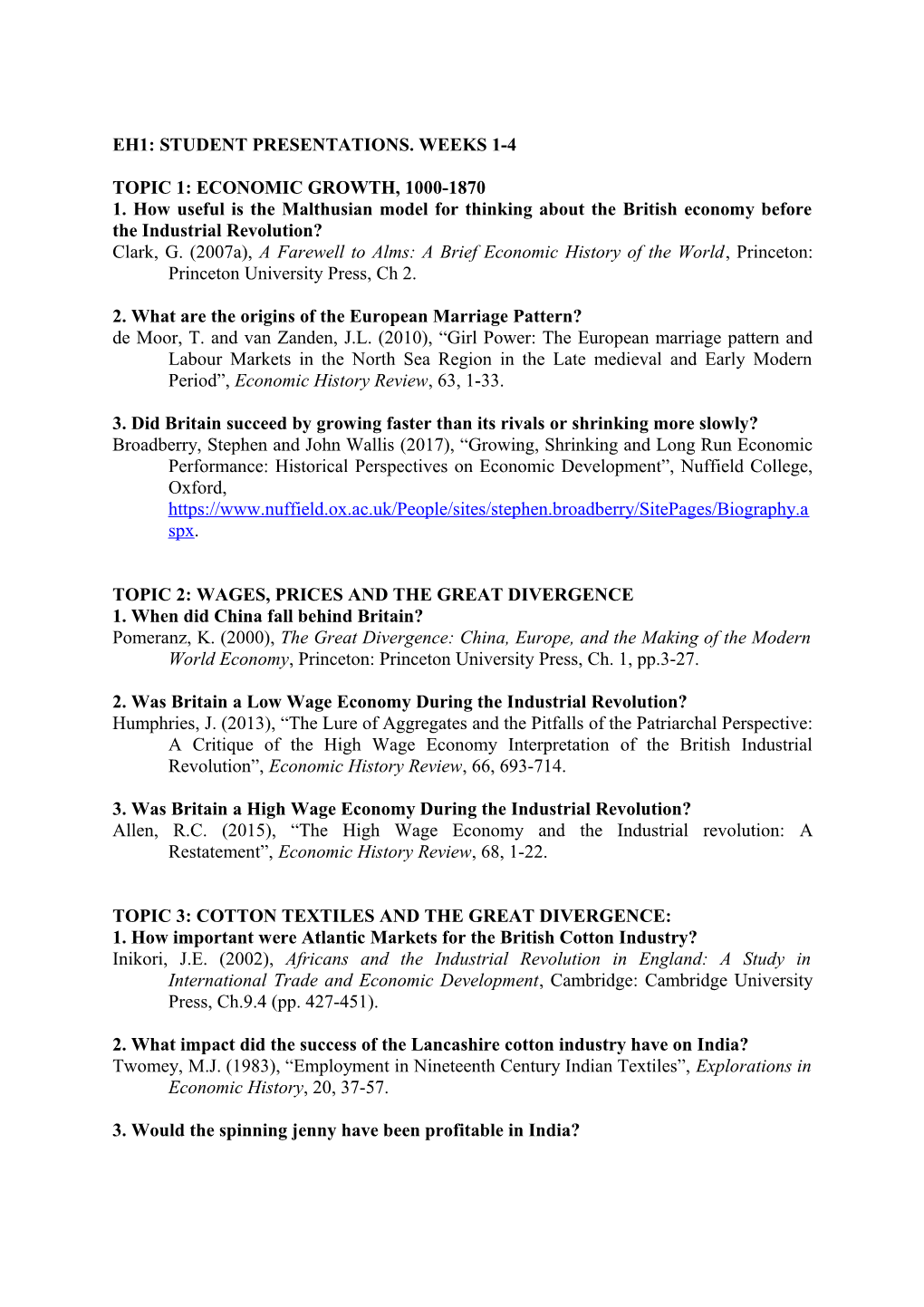EH1: STUDENT PRESENTATIONS. WEEKS 1-4
TOPIC1:ECONOMIC GROWTH, 1000-1870
1. How useful is the Malthusian model forthinking about the British economy before the Industrial Revolution?
Clark, G. (2007a), A Farewell to Alms: A Brief Economic History of the World, Princeton: Princeton University Press, Ch 2.
2. What are the origins of the European Marriage Pattern?
de Moor, T. and van Zanden, J.L. (2010), “Girl Power: The European marriage pattern and Labour Markets in the North Sea Region in the Late medieval and Early Modern Period”, Economic History Review, 63, 1-33.
3. Did Britain succeed by growing faster than its rivals or shrinking more slowly?
Broadberry, Stephen and John Wallis (2017), “Growing, Shrinking and Long Run Economic Performance: Historical Perspectives on Economic Development”, Nuffield College, Oxford,
TOPIC 2: WAGES, PRICES AND THE GREAT DIVERGENCE
1. When did China fall behind Britain?
Pomeranz, K. (2000), The Great Divergence: China, Europe, and the Making of the Modern World Economy, Princeton: Princeton University Press, Ch. 1, pp.3-27.
2. Was Britain a Low Wage Economy During the Industrial Revolution?
Humphries, J. (2013), “The Lure of Aggregates and the Pitfalls of the Patriarchal Perspective: A Critique of the High Wage Economy Interpretation of the British Industrial Revolution”, Economic History Review, 66, 693-714.
3. Was Britain a High Wage Economy During the Industrial Revolution?
Allen, R.C. (2015), “The High Wage Economy and the Industrial revolution: A Restatement”, Economic History Review, 68, 1-22.
TOPIC 3: COTTON TEXTILES AND THE GREAT DIVERGENCE:
1. How important were Atlantic Markets for the British Cotton Industry?
Inikori, J.E. (2002), Africans and the Industrial Revolution in England: A Study in International Trade and Economic Development, Cambridge: Cambridge University Press, Ch.9.4 (pp. 427-451).
2. What impact did the success of the Lancashire cotton industry have on India?
Twomey, M.J. (1983), “Employment in Nineteenth Century Indian Textiles”, Explorations in Economic History, 20, 37-57.
3. Would the spinning jenny have been profitable in India?
Allen, R.C. (2009), “The Industrial Revolution in Miniature: The Spinning Jenny in Britain, France, and India”, Journal of Economic History, 69, 901-927.
TOPIC 4: ACCOUNTING FOR THE GREAT DIVERGENCE
1. How did national income in Bengal compare with Britain in 1800?
Roy, T. (2010), “Economic Conditions in Early Modern Bengal: A Contribution to the Divergence Debate”, Journal of Economic History, 70, 179-194.
2. Were medieval states too strong?
North, D.C. and Weingast, B. (1989), “Constitutions and Commitment: Evolution of Institutions Governing Public Choice in Seventeenth Century England”, Journal of Economic History, 49, 803-832.
3. Were medieval states too weak?
Epstein, S.R. (2000), Freedom and Growth: The Rise of States and Markets in Europe, 1300-1750, London: Routledge, Ch.3, pp.38-72.
O'Brien, P.K. (2011), “The Nature and Historical Evolution of an Exceptional Fiscal State and its Possible Significance for the Precocious Commercialization and Industrialization of the British Economy from Cromwell to Nelson”, Economic History Review, 64, 408-446.
1
